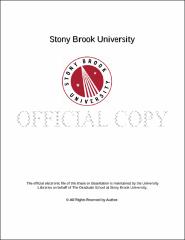| dc.identifier.uri | http://hdl.handle.net/11401/76319 | |
| dc.description.sponsorship | This work is sponsored by the Stony Brook University Graduate School in compliance with the requirements for completion of degree. | en_US |
| dc.format | Monograph | |
| dc.format.medium | Electronic Resource | en_US |
| dc.language.iso | en_US | |
| dc.publisher | The Graduate School, Stony Brook University: Stony Brook, NY. | |
| dc.type | Thesis | |
| dcterms.abstract | Cell migration is the critical process in the development and maintenance of multicellular organisms. It's a highly integrated multistep process that orchestrates a series of cellular behavior, such as embryonic development, wound healing and immune responses. A lot of effort has been dedicated to studying the basic principle and mechanism of cell movement since decades ago1-3. Cells can migrate in single cell or en masse fashion. We have already known that En masse cell migration is more related with physiological processes of tissue formation. And previous study has shown that cells would respond to different substrates, with various morphology or stiffness 4. Also, we believe there should be an evident and reasonable difference of migration fashions between young and aged cells as it should be. In this paper, we studied and demonstrated the migration of fluorescent human dermal fibroblast on PMMA flat thin film and fiber substrates on day 1,2,3,4 with en masse technique. We also applied P12, a fibronectin-derived cell survival peptide, on cells to see whether it could work in a positive way to promote cell migration as it did in enhancing cell survival in culture and improving wound healing in rat skin5. The results showed that cells move faster on aligned fibrous substrates than those on the planar thin film and the velocity on fiber would speed up as days went by. What's more exciting was that P12 accelerated cell migration on both kinds of substrates, which holds the potential to achieving fast wound healing. | |
| dcterms.available | 2017-09-20T16:50:01Z | |
| dcterms.contributor | Rafailovich, Miriam | en_US |
| dcterms.contributor | Sokolov, Jonathon | en_US |
| dcterms.contributor | Pinkas-Sarafova, Adriana. | en_US |
| dcterms.creator | Li, Kao | |
| dcterms.dateAccepted | 2017-09-20T16:50:01Z | |
| dcterms.dateSubmitted | 2017-09-20T16:50:01Z | |
| dcterms.description | Department of Materials Science and Engineering. | en_US |
| dcterms.extent | 42 pg. | en_US |
| dcterms.format | Monograph | |
| dcterms.format | Application/PDF | en_US |
| dcterms.identifier | http://hdl.handle.net/11401/76319 | |
| dcterms.issued | 2015-08-01 | |
| dcterms.language | en_US | |
| dcterms.provenance | Made available in DSpace on 2017-09-20T16:50:01Z (GMT). No. of bitstreams: 1
Li_grad.sunysb_0771M_12164.pdf: 1535170 bytes, checksum: 891877803d024689f3f96844bc4ba0ff (MD5)
Previous issue date: 2014 | en |
| dcterms.publisher | The Graduate School, Stony Brook University: Stony Brook, NY. | |
| dcterms.subject | Materials Science | |
| dcterms.title | Effects of Aligned Fiber Substrates and P12 Peptide on Cell Migration | |
| dcterms.type | Thesis | |

